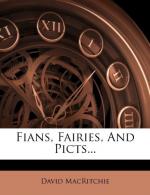Of the little woodcut which forms the Tailpiece of this volume, it is hardly necessary to say that it represents some popular ideas regarding “the little people.” The woodcut of which this is a facsimile is one of those contained in the eighteenth-century chap-book, “Round about our Coal Fire; or, Christmas Entertainments,” and it heads the chapter “Of Fairies, their Use and Dignity.” “They generally came out of a Mole-hill,” it is said; “they had fine Musick always among themselves, and Danced in a Moonshiny Night around, or in a Ring as one may see at this Day upon every Common in England, where Mushroones [sic] grow,” The size of the mushroom, so elegantly depicted in the foreground, is quite on a scale suitable to the stature ultimately accorded to the little people in many districts; so also is the mole-hill. But the tree, and the Satanic head in the foliage, are curiously out of proportion.
* * * * *
An examination of these various diagrams will show that the more primitive of those structures were obviously built by a small-sized race; some of the passages being quite impassable to large men of the present day. This peculiarity was noticed by Scott when visiting the “brochs” of Shetland, a kindred class of structures (none of which are here shown). “These Duns or Picts’ Castles are so small,” he says, writing in his Diary in August 1814, “it is impossible to conceive what effectual purpose they could serve excepting a temporary refuge for the chief.” This reflection was suggested to him by the Broch of Cleik-him-in (now usually written Clickemin), near Lerwick; and in describing it he says: “The interior gallery, with its apertures, is so extremely low and narrow, being only about three feet square, that it is difficult to conceive how it could serve the purpose of communication. At any rate, the size fully justifies the tradition prevalent here, as well as in the south of Scotland, that the Picts were a diminutive race.” Of the Broch of Mousa he says: “The uppermost gallery is so narrow and low that it was with great difficulty I crept through it,”—a feat which baffled the present writer.[94] In all those cases, of course, it is understood one has to crawl. As with the Lapps and the Eskimos, creeping was much more a matter of course with the builders of those places than it is with us. After getting through such passages it happens that, in several instances, the roof is higher than is required for the tallest living man. An admirable example of such a place is the underground “Picts’ House” at Pitcur, in Forfarshire, which would be quite a palace to people of a small race, and very likely figures as such in some popular tale; its dimensions and appearance considerably magnified with every century.[95] But even this “fairy palace” was entered by narrow, downward-sloping passages, similar to that seen in the Frontispiece, down and up which the dwellers




